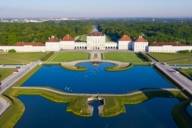
Schloss Nymphenburg served as a summer residence for the Electors and Kings of Bavaria in the 18th century. Today, the 180-hectare complex with its palace park is the second largest green space in Munich – in addition, Nymphenburg is one of the largest palaces in Germany and one of the most important in Europe.
- Year of construction and origins of Schloss Nymphenburg
- The “Schönheitengalerie“ of King Ludwig I.
- The Hubertus Hall: Concerts in the Orangery Wing
- The story of Nymphenburger Schlosspark (Palace Park)
- Amalienburg to Pagodenburg – Park Palaces at Nymphenburg
- Marstallmuseum and the “Mensch und Natur“ Museum
- Porzellanmanufaktur Nymphenburg
- Getting to Nymphenburg
- Opening hours of Schloss Nymphenburg and the Palace Park
Elector Ferdinand Maria gave the castle to his wife Henriette Adelaide of Savoy for the birth of their long-awaited son Max Emanuel. Construction began in 1664, and around 1679 the palace was almost completed in its first form – so it is now over 325 years old. At that time, hardly imaginable today, Nymphenburg was located in an open field, two hours away from the city centre and the Residenz in Munich. Today it is a green oasis for everyone and with its extensive palace park one of the most important recreational areas in the city.
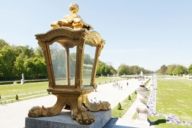
The master builders Agostino Barelli and Enrico Zuccalli originally designed Nymphenburg as a baroque palace. Its rococo and neoclassical elements were not added until later on. Over the course of two centuries, the architect Joseph Effner, among others, transformed it from a small country house into a large three-winged complex. The centre of the castle is the “Steinerner Saal“ with its cycle of frescoes framed by luxuriant rococo stuccoes. On both sides of the Stone Hall are the princely living and reception rooms.
The palace grew again to reach its current size under the reign of Elector Max Emanuel (1680 to 1726). A tour offers visitors the chance to glimpse the room in which King Ludwig II was born as well as King Ludwig I's world-famous Schönheitengalerie (Gallery of Beauties), which used to be the living quarters of Queen Caroline, the wife of King Max I Joseph. The painter Joseph Stieler was commissioned by the king to paint a total of 36 portraits of women from all walks of life – including, for example, the “beautiful Munich girl“ Helene Sedlmayr, daughter of a master shoemaker, and the dancer Lola Montez, the king's mistress. One of the works was unfortunately lost, but the painter Friedrich Dürck added two more portraits in 1861.
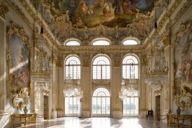
In the northern wing of the castle complex, several rooms can be rented for public events as well as private functions. In addition to the Orangery Hall and the St. John's Hall, there is also the 350-square-metre Hubertus Hall, which is mainly used for concerts, theatre and gala dinners. There is room for up to 400 people with concert seating in the banqueting hall – on selected days, classical concerts are performed here, which are very popular with both locals and guests of the city.
Nymphenburg is not just home to the Bavarian royal family's lavish palace; the grounds also include a large park containing unique water features, an extensive selection of sculptures and unusual pavilions. Over the years, the original baroque flower gardens underwent numerous changes and expansions up until the 19th century, when they became the English-style gardens they are today. Their picturesque design was created by the famous landscape gardener Friedrich Ludwig von Sckell.
The first work on the park was begun in 1701 by Elector Max Emanuel, and the Nymphenburg Park was completed in 1715. Around 1800, however, the Bavarian Elector Max IV Joseph commissioned a landscape redesign – the regular baroque garden was to become a natural landscape garden with natural lakes and streams. Today, the park covers an area of 180 hectares and has retained its natural form. There are also lots of wild animals in the park, such as deer, beavers, adders, kingfishers, tawny owls and geese – our author went on an early morning safari through Nymphenburger Schlosspark.
For your interest: The Schloss Nymphenburg and Garden Administration will receive a new wood chip system in the coming years. In addition, it is being examined which parts of the building can be heated alternatively.
If you are interested in visiting the pavilions, we recommend planning a long walk through the palace's 200 hectare park. Thanks to their symmetrical layout, it is easy to explore the Badenburg pavilion and its magnificent swimming pool, the Asian-inspired Pagodenburg, the Magdalenenklause (a building designed to resemble an artistic ruin), and the Amalienburg hunting lodge.
The Badenburg next to the lake of the same name is considered to be the first heated indoor swimming pool of modern times – inside you will find a two-storey banqueting hall, the electoral flat and a magnificent bathing hall. From the 1720s, people bathed here between stucco marble slabs, Dutch tiles and a wonderful ceiling painting. Across the canal is the Pagodenburg, intended as a retreat after a game on the Mailbahn. The building impresses with its many Chinese figures, pagodas and elements such as the special wallpaper. To this day, the Pagoda Castle is considered a major work of 18th century “Chinese fashion“.
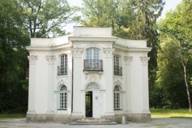
The third park building erected by the master builder and garden architect Joseph Effner was the Magdalenenklause in the palace garden: this stands somewhat overgrown in a small wood, the interior is a mixture of chapel and cosy parlour. This place served as a retreat for Elector Max Emanuel. And opposite the Magdalenenklause stands the famous Amalienburg: built in the 1730s by Elector Karl Albrecht for his wife Maria Amalia as a pleasure and hunting lodge. Even today, the Amalienburg is one of the most precious creations of the European Rococo!
The main building of Schloss Nymphenburg houses three exciting museums: the Marstallmuseum with the Nymphenburg Porcelain Museum in the southern wing and the Mensch und Natur Museum in the northern wing. The latter is particularly popular with school classes – here children, young people and adults alike can learn all there is to know about natural history. You can try your hand interactively through the nine thematic areas – from genes to the human brain, from minerals to the Stone Age.
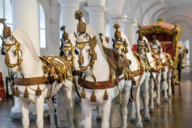
In the Marstallmuseum, on the other hand, you can learn everything about carriages and royal travel: Over forty carriages, sleighs and riding accessories owned by the Wittelsbach dynasty from the last 300 years are on display. Besides the precious riding accessories and the historical photos, the highlight is definitely the coronation carriage of Emperor Charles VII. And it is no coincidence that the Marstallmuseum is located right here: The southern cavalier buildings of Schloss Nymphenburg used to be the “Leibpferde-Stallung“, where the courtly horses were stabled during the summer months.
The first floor of the Marstallmuseum also houses the Nymphenburg Porcelain Museum – here visitors can admire a unique private collection of Nymphenburg porcelain from the 18th to the 20th century. The Porzellanmanufaktur Nymphenburg (porcelain manufactory) was founded in 1747 by Max III Joseph, and since 1760 production has been carried out exclusively in the workshops at Schloss Nymphenburg, with electricity drawn from the palace canal. Each piece is lovingly handcrafted, the porcelain painters spend a whole week working on a single plate. Porzellanmanufaktur Nymphenburg has been an intangible world cultural heritage site since 2016.
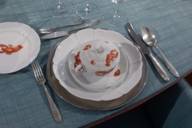
There are two different ways to get to Schloss Nymphenburg by public transport: Visitors can either take the S-Bahn to the “Laim“ stop – as this station is still on the main line, almost all S-Bahn trains pass by here. From Laim it takes about 20 minutes to walk to the Schlosspark or take the bus to the “Schloss Nymphenburg“ stop. Alternatively, you can take the underground to the “Rotkreuzplatz“ stop and change to the tram to “Schloss Nymphenburg“.
Car drivers will find around 450 free parking spaces on site, but the palace is also particularly suitable for a short bike trip: it only takes 25 minutes by bike from the main station. Or you can do as our author did and combine the destination with a short city walk from east to west.
Schloss Nymphenburg and Marstallmuseum with Nymphenburg Porcelain Museum
April to 15 October: daily 9 am - 6 pm
16 October to March: daily 10 am - 4 pm
Park castles (Amalienburg, Badenburg, Magdalenenklause, Pagodenburg)
April - 15 October: daily 9 am - 6 pm
16 October - March: closed
All objects are closed on the following days: 1 January, Shrove Tuesday, 24, 25 and 31 December.
Last admission to all objects is 30 minutes before the end of the stated opening time.
Nymphenburger Schlosspark (main gate opening hours)
November, December, January, February, March: 6 am-6 pm
April and October: 6-20 hrs
May to September: 6-21.30 hrs.
The other park gates close ½ hour earlier.
More details and all further information can be found at www.schloss-nymphenburg.de.
Good to know: Munich Card holders are entitled to a reduced admission fee. If one owns the Munich City Pass, the entrance is free of charge. No matter which card you choose, the public transport is included.